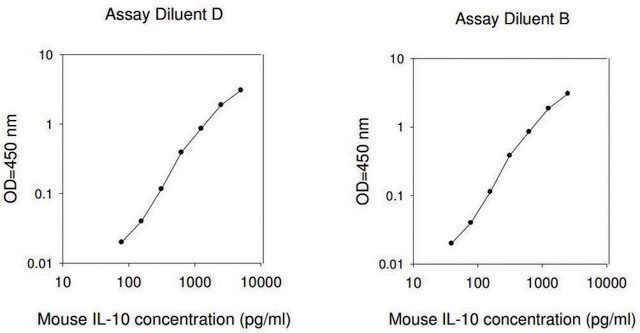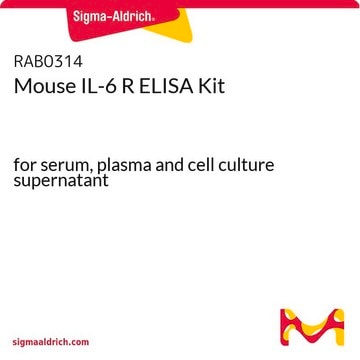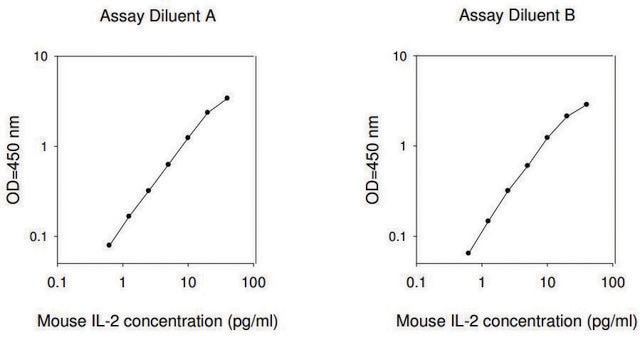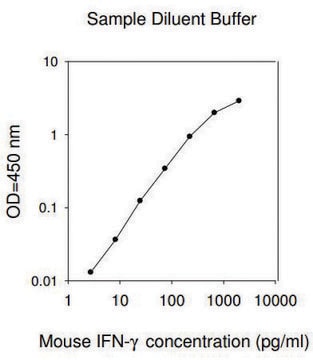The Assay/Sample Diluent Buffer (Item E2) should be diluted 5-fold. This 1X Assay/Sample Diluent Buffer is used to dilute serum, plasma, or medium samples a recommended 2 fold. Please note that the levels of IL-6 may vary between different samples. Optimal dilution factors for each sample must be determined by the investigator.
RAB0308
Mouse IL-6 ELISA Kit
for serum, plasma and cell culture supernatant
Synonym(e):
B-cell stimulatory factor 2, CTL differentiation factor, Hybridoma growth factor, IFN-beta-2, IL-6, Interferon beta-2
Größe auswählen
€ 611,00
Größe auswählen
About This Item
€ 611,00
Empfohlene Produkte
Speziesreaktivität
mouse
Verpackung
kit of 96 wells (12 strips x 8 wells)
Methode(n)
ELISA: suitable
capture ELISA: suitable
Aufnahme
sample type plasma
sample type cell culture supernatant(s)
sample type serum
assay range
inter-assay cv: <12%
intra-assay cv: <10%
sensitivity: 2 pg/mL
standard curve range: 0.82-600 pg/mL
Nachweisverfahren
colorimetric
Versandbedingung
wet ice
Lagertemp.
−20°C
Angaben zum Gen
mouse ... Il6(24498)
Verwandte Kategorien
Allgemeine Beschreibung
Immunogen
Anwendung
Biochem./physiol. Wirkung
Sonstige Hinweise
Please type the word sample in the text box provided for lot number.
Empfehlung
Signalwort
Warning
H-Sätze
P-Sätze
Gefahreneinstufungen
Met. Corr. 1
Lagerklassenschlüssel
8A - Combustible corrosive hazardous materials
Hier finden Sie alle aktuellen Versionen:
Besitzen Sie dieses Produkt bereits?
In der Dokumentenbibliothek finden Sie die Dokumentation zu den Produkten, die Sie kürzlich erworben haben.
Kunden haben sich ebenfalls angesehen
-
Hello. How much should I dilute tissue culture media for the assay? 2-fold? Thanks.
1 answer-
Helpful?
-
-
マウスのパイエル板をホモジナイズした上清で測定は可能ですか?
1 answer-
This product is suitable with serum, plasma, and cell culture supernatant. However, it has not been determined if this product can measure the supernatant obtained by homogenizing mouse Peyer's patches. This application will need to be validated by the end-user.
While the requested ELISA kit nor any of the offered normal ELISA kits are neither designed nor validated with cell/tissue lysate samples, our kits are very accommodating to many different sample types so lysates will most likely work. If it is decided to test these kits with cell/tissue lysate samples, it is recommended to dilute the samples at least 5-fold with Assay Diluent to minimize any effects of the detergents in the lysis buffer. The samples may need to be diluted further but this would need to be determined by the experimenter empirically.
So for the original lysate, in general it is recommended to shoot for at least 1 mg/ml protein, preferably more, to achieve 50-500 ug/ml after dilution. Again though, this range should just be used as a starting point and the optimal concentration would need to be determined empirically.
Below are some general guidelines for doing so along with some basic tips for sample preparation.
Tips on Sample preparation
In brief, a lysis buffer must meet the following specifications:
A) has relatively low salt content (700 mM or less)
B) does not contain sodium azide
C) does not contain >0.1% SDS
D) does not contain >10 mM reducing agents (beta-mercaptoethanol or dithiothreitol)
This would include any buffers used for immunoprecipitations, including RIPA buffer.Helpful?
-
Active Filters
Unser Team von Wissenschaftlern verfügt über Erfahrung in allen Forschungsbereichen einschließlich Life Science, Materialwissenschaften, chemischer Synthese, Chromatographie, Analytik und vielen mehr..
Setzen Sie sich mit dem technischen Dienst in Verbindung.

















